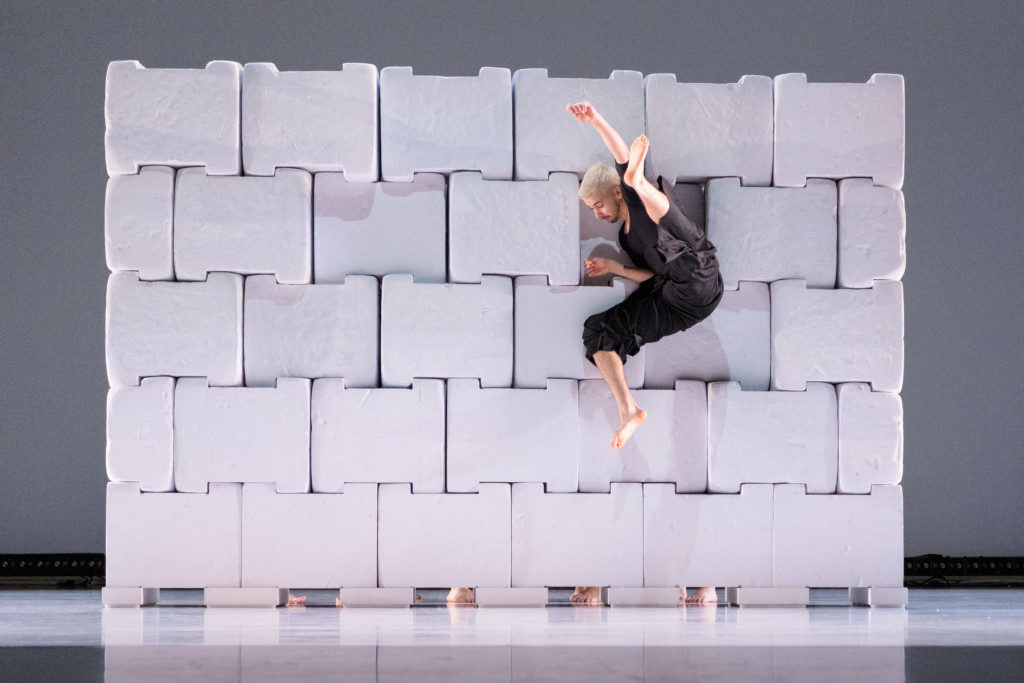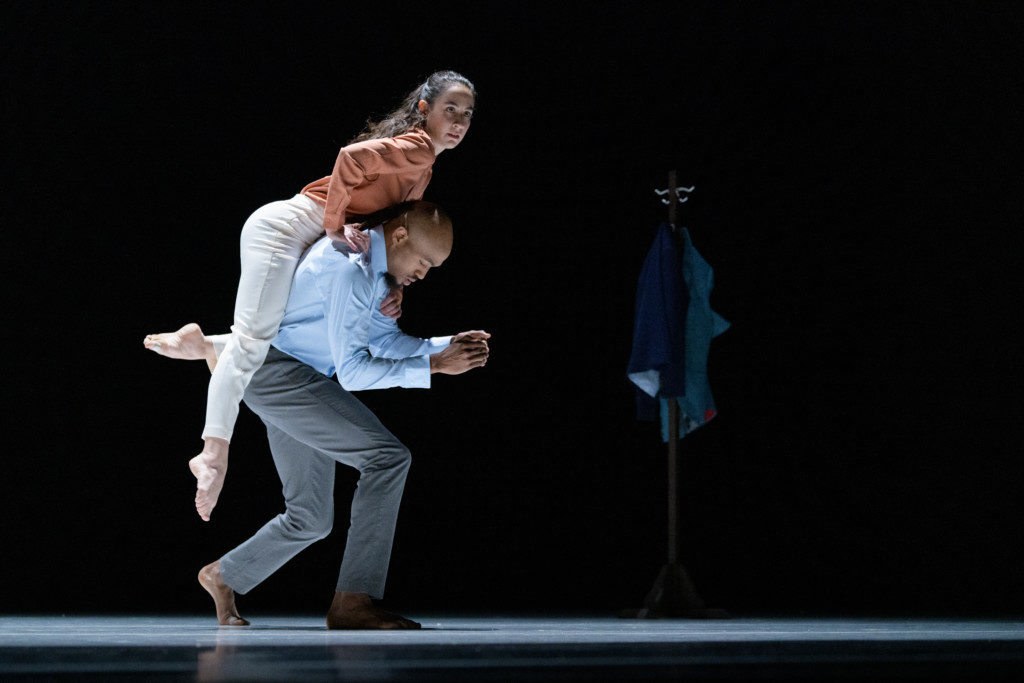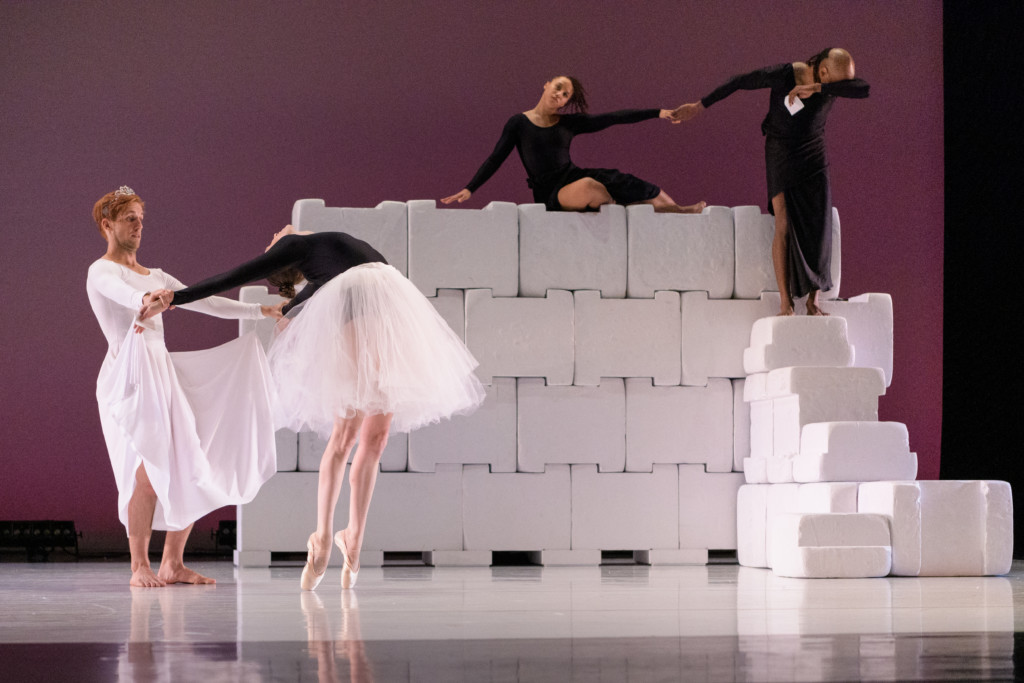Ann Carlson’s Elizabeth, the dance, is the supreme example of an organic, living work of art. And, the six current dancers of Ririe-Woodbury Dance Company nurtured and nourished it in a rich, superb performance in Traces, the opening concert of the company’s 56th season.
As The Utah Review mentioned in an earlier preview, the 2017 work is, in one aspect, Carlson’s autobiography but it also encompasses so many other facets that are homages to everyone she has countered in her life. The most compelling, however, is what gives the work its greatest creative power: the impact of dance’s impressive genealogy, as synthesized by Carlson, on the six performing artists and the living institution of Ririe-Woodbury. Since its premiere two and a half years ago, the work has seen four new dancers join the process. It’s a work that has been acclaimed in performances on the other side of the country and was part of Ririe-Woodbury’s 2018 cultural ambassador tour in Mongolia and South Korea.

While Elizabeth, the dance encompasses many vignettes, they are fused in the most lucid, generous, approachable manner imaginable. And, all six dancers (Bashaun Williams, Melissa Rochelle Younker, Megan McCarthy, Brian Nelson, Dominica Greene and Nick Jurica) displayed exquisite chemistry. Rest assured, a 2021 performance of this work would be nurtured and nourished with even new insights distinct from this 2019 rendition.
A significant element in Carlson’s mind with this work is the audience connection. Reiterating a point Carlson made in an earlier interview, “every dance work needs the audience and its “heart, mind, soul and spirit” and it is not complete until “they’re here.” The beginning of Elizabeth, the dance is in silence, as the dancers size up a wall of large interlocked foam blocks stacked in rows of up to six units each. The wall and its components become versatile props throughout the work with different strategic purposes. Carlson’s premise is cosmopolitan and ecumenical so audiences are encouraged to make their own enlightened interpretation without fear of being told it’s wrong or irrelevant.

The opening silence lasts more than a few moments, as the dancers instinctively absorb the audience’s vibe in the Jeanné Wagner Theatre, waiting for the right second of time to proceed. The dancers individually attempt to topple the wall, while each verbally ad-libs their support to each other. Finally, the wall is brought down and the blocks are scattered amidst the dancers’ jubilation. The musical soundscape, sometimes so subtle but yet powerful to amplify a characteristic tone of a specific vignette, is the work of Torry Bend and Matthew McMurray.
Walls are powerful metaphors that have become especially menacing in contemporary society. They represent the most basic form of communication. Throughout the work, the large foam blocks serve variously as props but they also are reconstructed periodically as intact walls, just as at the start of Elizabeth, the dance. Choreographers and dancers are familiar with walls especially when they insulate a particular creative community and signal “others” to stay away. One of the most instructive developments among local performing arts groups in Salt Lake City has been not to just tear down the fourth wall to engage an audience but also to immerse the audience in intimate ways that revolutionize staging and production standards (Think of Sackerson’s A Brief Waltz in a Little Room: 23 Short Plays about Walter Eyer). Walls sometimes are even schizophrenic, as Marc Silberman, who co-edited the anthology Walls, Borders, Boundaries: Spatial and Cultural Practices in Europe, described, harkening back to his experience as a college student in Berlin when the city was divided by a wall.

The dancers highlight why walls are not just physical separators. Throughout the 75 minutes of the work, standing walls always are being penetrated and redefined. Even when the blocks of the wall are disassembled, they convey narrative epiphanies associated with the idea of a wall. In one vignette, we hear a recorded voiceover by Williams relating a story from his childhood, accompanied by his own movement. He recalls going with family members to a baseball game but they did not have enough money to cover tickets for everyone. But, then a mysterious stranger – an angel – gives them enough tickets, free of charge, so they can enter the ballpark. The scene meanwhile is interpreted by the dancers in a unique setting. Similarly, in a scene quoting Isadora Duncan, the company’s newest dancers – Greene and Jurica – make the compelling case of inclusion. No one’s dreams should ever be deterred by a wall, metaphorically or physically.
In another scene, the dancers emerge from behind the wall in various forms of clown costume and makeup and the cycle continues as the dancers disappear behind the wall, only to emerge again in different getups. As they move and amble on almost as if they are on some bizarre assembly line, they tug at their oversized clothing, rub their body parts and shift about mischievously. In dance, as in music and other performing arts, the innovative breakers of precedent sometimes are laughed at and ridiculed by their creative communities and peers. As we have found, what might be dismissed as nonsense or trivial novelties of the avant-garde in one era gain their right places in the creative world a generation or two later. A wall is reconstructed to protect and preserve this new cycle, only to be penetrated again by the next wave of precedent breakers.

There are moments of classicism in movement, with Younker posing on a pedestal in one scene while in another McCarthy, dressed as a ballerina, executes the required movement. However, she is interrupted several times by Daniel Charon, Ririe-Woodbury’s artistic director, who is standing in the aisle with a microphone. He asks her to repeat it until she has nailed the movement. Technical perfection is frustrating and exhausting.
Throughout the work, Carlson quotes dance expressions from several giants of modern dance, including Doris Humphrey, Isadora Duncan, José Limón, Mary Wigman, Trisha Brown and Alwin Nikolais, among others. However, while these quotations are immediately recognized by those who have performed and worked in the dance community, they also are framed and contextualized so that they never appear to be ‘inside baseball’ or esoteric gestures to others in the audience. The work is never heavy in abstraction or over-intellectualized. Its serious purpose is lightened throughout with encouragement of laughter and the nonverbal gestures and chemistry of the dancers. They make it effortless even as it demands so much of them physically and technically.

The work’s integral organic nature arises from its multifarious elements: the wall of detachable foam blocks, the unisex long black costumes that are reconfigured in various forms and the distinctive personalities of the dancers. Spoken text is prevalent throughout the work. Likewise, we hear recorded snippets of one of her sons, when he was very young, reading excerpts from The Art of Making Dances, the 1938 book by Humphrey. The final excerpt is simply “don’t leave the end to the end” – which is precisely what occurs in Carlson’s piece.
True to the objective of having the audience to complete the work, the dancers fan out and deliver bags of popcorn, accompanied by a rousing chorus of Auld Lang Syne. Audience members flocked onto the stage, as The Beatles’ classic When I’m Sixty-Four played and Charon sat in a chair, thinking about what movement should he dance. Once the song Moses Supposes from Singin’ In The Rain appears, he launches into a full-blown tap routine, with everyone – Carlson, dancers and audience – cheering him.

Leading this smashing success of a season opener was the premiere of a duet for Williams and Younker, choreographed by Charon, and featuring as musical accompaniment, the distinctive baritone of Leonard Cohen’s 1988 masterpiece song Everybody Knows. It was the perfect appetizer to Carlson’s work – a multidimensional reflection of angsty, mellifluous and affirming tones of hard-earned confidence in a dancer’s world.
Traces could not have been a more ideal opener for Ririe-Woodbury’s new season, which truly emphasizes audience connection and engagement. For its Allegory concert (Jan. 31- Feb. 1) it will restage and recast the live creature and ethereal things, a 2019 world premiere set by Charon with Dallas Graham of the Red Fred Project and the Flying Bobcat Theatrical Laboratory. Charon also will set a new work for that concert.

